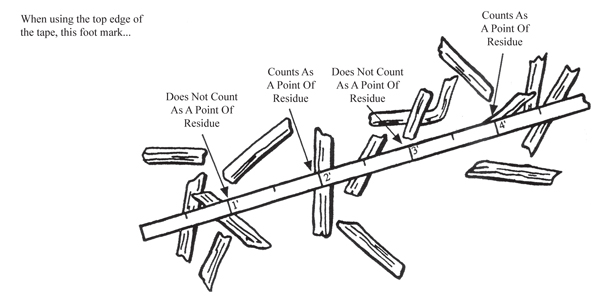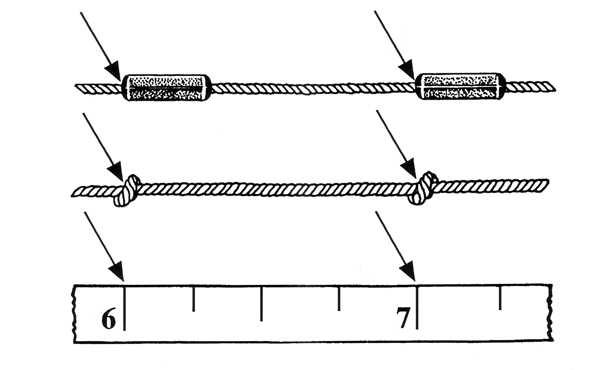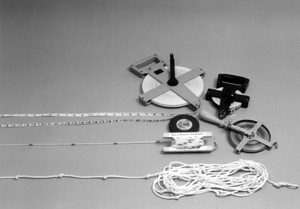G1931
Estimating Percent Residue Cover Using the Line-Transect Method
This NebGuide describes how to use the line-transect method to estimate the percentage of the soil surface covered with crop residue to help control soil erosion.
David P. Shelton, Extension Agricultural Engineer
Paul J. Jasa, Extension Engineer — Conservation Tillage
Crop Residue and Soil Erosion
Leaving crop residue on the soil surface is one of the easiest and most cost-effective methods of reducing soil erosion. Research in Nebraska and other midwestern states has shown that leaving as little as 20 percent of the soil surface covered with crop residue can reduce soil erosion by one-half of what it would be from residue-free conditions. Greater amounts of residue cover will further reduce erosion.
Many Conservation Plans specify crop residue management or residue left on the soil surface as the primary erosion control method. Generally, the amount of cover required after planting ranges from 30 percent to as much as 85 percent. Thus, it is important to accurately determine percent residue cover to verify effective erosion control and compliance with a Conservation Plan.
Residue cover cannot be estimated merely by looking across a field. Such estimates, often attempted from the road or edge of the field, grossly overestimate the actual amount of cover. Accurate estimates of residue cover can only be obtained from measurements taken within the field, while looking straight down at the soil and residue.
Line-Transect Method
The line-transect method is one of the easiest and most accurate methods of estimating percent residue cover. A 100-foot measuring tape is used most often, but other tape lengths, specially made cords with “beads” attached, or knotted ropes will also work, (Figure 1). For convenience, there should be 100 easily visible marks on the measuring device.
|
To use the line-transect method, the measuring device is first stretched across a section of the field. By counting the number of marks on the measuring device directly over a piece of residue you can figure the percent of residue cover. Following is a step-by-step procedure:
Find a representative area. Select an area that is representative of the whole field. Avoid end rows, or small areas of the field that have been adversely affected by flooding, drought, weed or insect infestations, compaction or other factors that have substantially reduced yields or affected residue cover.
Stretch tape or line diagonally across crop rows. Anchor one end of the tape or line and stretch it diagonally at about a 45° angle across the crop rows so it crosses more than one pass of the implements used. This avoids inaccurate readings such as those obtained if all measurements were taken in a windrow of residue left by the combine, or in an area of reduced amounts of residue. Do not take measurements parallel or perpendicular to crop rows.
Check for residue at each mark. Determine residue cover by counting the number of marks that are directly over a piece of residue. (An inexpensive click or lap counter, available at sporting goods stores, can help keep count.)
When looking at the tape and counting, follow these rules:
1. Keep both ends of the tape anchored and do not move the tape.
2. Look straight down at the tape and marks.
- Leaning from side to side will result in overestimation because residue may appear to be under the mark when it really is not.
- To get an accurate measurement, count only those marks that have residue exactly under them (Figure 2).
 |
| Figure 2. While consistently looking at only one side of the measuring device, count only those marks that have a piece of residue beneath them. |
3. Consistently look at the same side of the tape.
4. Consistently look at the same point at each mark.
- This is especially important when using a knotted rope or cord with attached beads. The knot or bead covers a relatively large area, and if residue at any location under the mark is counted, overestimation will result. Instead, always focus on a small, single point such as where the bead meets the cord (Figure 3).
5. Do not count if questionable.
 |
| Figure 3. At each mark, consistently focus on a single point on the same side of the measuring device, rather than on the entire mark. |
Residue Size
To effectively reduce erosion, a piece of residue needs to be large enough to dissipate the energy of a raindrop during an intense storm. Consider a dot of 3/32 inch in diameter as the minimum size suggested for residue to be counted. Use your judgment, but if you are not sure whether the piece of residue is large enough to absorb the raindrop energy, do not count it.
One way to determine if a piece of residue is large enough to count is to use a 3/32 inch diameter brazing rod, wooden dowel, or the unsharpened lead from a wooden pencil. The end of the rod is used to touch the residue at each mark. If the piece of residue extends completely beyond all edges of the rod, count it. If the rod completely covers the piece of residue, or if part of the rod end extends beyond the edge of the residue at any location, the point shouldn’t be counted, because a raindrop falling on this location would strike some bare soil (Figure 4).
 |
| Figure 4. Measuring tape and 3/32 inch diameter rod are being used to determine whether or not to count a piece of residue. |
Determine percent cover. When 100 points are observed, the number of marks that are directly over residue will be a direct measurement of the percent cover for that area of the field. That is, if 35 marks on a 100 foot tape were observed to be exactly over a piece of residue, then the residue cover is 35 percent.
If less than 100 points are observed, multiply the count by the appropriate conversion factor to obtain percent cover. For example, if a 50-foot tape is used, and only the foot marks are observed, multiply the count by two.
Take at least three measurements. For increased accuracy, repeat the measuring process in three or more representative areas of the field. Average the individual measurements to obtain an estimate of percent cover for the entire field.
Conclusion
Crop residue management, or leaving residue on the soil surface, is the most cost-effective method of reducing soil erosion available to Nebraska farmers. Accurate measurements of percent residue cover are needed to determine if enough cover is present to adequately reduce erosion and to comply with a Conservation Plan. The line-transect method is one of the easiest and most accurate methods of determining percent residue cover.
This publication has been peer reviewed.
Visit the University of Nebraska–Lincoln Extension Publications Web site for more publications.
Index Crop Production/Field Crops
Conservation Management
Issued February 2009
